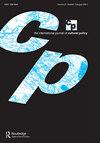EU heritage diplomacy: entangled external and internal cultural relations
IF 1.6
3区 社会学
Q2 CULTURAL STUDIES
引用次数: 5
Abstract
ABSTRACT Cultural heritage is an expanding yet contested area of EU policymaking, which has recently been identified as an instrument for EU international cultural relations. In this article, drawing from critical heritage studies and recent scholarship on heritage diplomacy, we see external and internal cultural relations as blurred and deeply entangled in EU heritage policies. Empirically, we focus on the European Heritage Label (EHL), a central EU heritage policy instrument. We explore how heritage practitioners at selected EHL sites and EU heritage policymakers understand and give meanings to international cultural relations and explain the role of cultural heritage in diplomatic endeavours. Our method is a dynamic frame analysis of 44 interviews conducted in the European Commission and at eleven EHL sites in ten European countries. The analysis identified four frames of international cultural relations in the data: relations with non-EU countries for peace and stability building, showcasing and branding of cultural heritage for foreign audiences, creating unity in Europe, and small-scale international heritage projects. These frames manifest different understandings of heritage diplomacy ranging from geoculture to shared heritage and from intercultural encounters to the use of soft power.欧盟遗产外交:内外文化关系的纠缠
文化遗产是欧盟政策制定的一个不断扩大但有争议的领域,最近被确定为欧盟国际文化关系的工具。在这篇文章中,通过对遗产外交的批判性研究和最近的学术研究,我们看到外部和内部的文化关系在欧盟遗产政策中是模糊的,并且深深地纠缠在一起。根据经验,我们关注欧洲遗产标签(EHL),这是欧盟遗产政策的核心工具。我们将探讨选定的EHL遗址的遗产从业者和欧盟遗产政策制定者如何理解和赋予国际文化关系意义,并解释文化遗产在外交努力中的作用。我们的方法是对在欧盟委员会和10个欧洲国家的11个EHL站点进行的44次访谈进行动态框架分析。该分析在数据中确定了国际文化关系的四个框架:与非欧盟国家建立和平与稳定的关系,向外国观众展示和推广文化遗产,在欧洲建立团结,以及小规模的国际遗产项目。这些框架体现了对遗产外交的不同理解,从地缘文化到共同遗产,从跨文化接触到软实力的使用。
本文章由计算机程序翻译,如有差异,请以英文原文为准。
求助全文
约1分钟内获得全文
求助全文

 求助内容:
求助内容: 应助结果提醒方式:
应助结果提醒方式:


